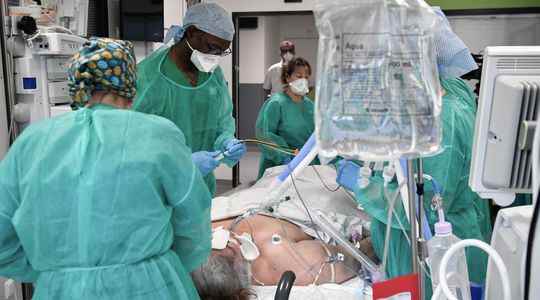“We remain at more than a hundred deaths per day, but society seems to be doing with it”. Djillali Annane, head of the intensive care unit at Raymond-Poincaré hospital in Garches, has a good idea of the effects of Covid-19. In his department, still nearly a third of patients are cared for for or with a Covid-19 infection. “We no longer see young patients, without underlying illnesses which form serious forms, but we continue to have regular arrivals of fragile patients who go to intensive care because of the Covid”, he notes. For nearly a month, the number of deaths linked to Covid-19 has stabilized at a relatively high level. On average over the last seven days, 110 deaths were thus recorded daily. A much lower level than at the start of the health crisis, when French hospitals saw more than 500 deaths per day disappear during the peak, but which remains relatively high as the epidemic becomes more commonplace within the population, and in virus control policies.
Who are these patients who continue to succumb to the coronavirus? In a study published in March, the Department of Research, Studies, Evaluation and Statistics (Drees) made a now well-known observation: men, and in particular older men, are more likely to die from Covid-19. The study thus underlined that the median age of the deceased is 82 years, the over 80s represent 60% of all hospital deaths. It also shows that hospital mortality is higher among men (12%) than among women (8%) and reaches 42% among men aged 80 or over.
Lower protection in older people
“People hospitalized for serious cases in intensive care have been the same for several months, they are unvaccinated patients, or with comorbidities, or immunocompromised”, specifies Yves Cohen, the head of the intensive care unit at Avicenne hospital in Bobigny. . Widespread vaccination, and the presence of a less virulent Sars-Cov-2 variant, have made it possible to greatly reduce the number of serious cases caused by the disease. The patients who are today in critical care units are therefore overwhelmingly fragile patients, often affected by other pathologies, or whose immune system is not sufficiently efficient.
As a result, in-hospital mortality has fallen slightly since the outbreak began. According to figures from DREES, 20% of patients hospitalized in these last-chance units end up dying in hospital across all waves. This rate is stable for the first three waves with a proportion of around 20% for the first three, then drops to 14% during the fourth, details the Drees. “The therapies have made it possible to reduce the number of people whose condition evolves towards severe forms, but in this last category the proportion of deaths unfortunately remains relatively stable”, explains Djillali Annane.
While before the arrival of the vaccine the elderly, without any comorbidities, were very exposed to the virus, the first injections as well as the booster dose continue to confer strong protection against the serious forms. But as the months pass, for those over 60, many of whom received their first booster dose from the fall, protection against severe forms could start to gradually fade. Even if the number of daily hospital admissions among the over 60s is still much lower than at the peak of the previous wave, it was up in early April in conventional hospitalization as well as in critical care.
preventable deaths
“We actually always see people arriving in intensive care with forms of Covid-19 requiring hospitalization in intensive care, these are fragile people, who are mostly far from their last injection”, confirms Djillali Annane. Those over 75 are in fact subject to a phenomenon of immunosenescence with a progressive loss of immunity allowing them to protect themselves from infection and transmission, but also over time of “memory” immunity, another level of immune defenses on which protection against severe and serious forms is based. “There is a slight increase in hospitalizations in these categories, which is why the drop in this protection is one of the elements taken into account in the recommendation of a second booster dose for the elderly”, evokes Public Health France.
Finally, the doctors note that with vaccination, and the lower virulence of Omicron, the cases evolve. “Hospital pressure remained concentrated on the geriatric sectors, due to the decompensation of pre-existing polypathologies in these fragile and Immuno-senescent populations”, reported on Twitter, Clarisse Audigier-Valette, pneumo-oncologist at the Toulon hospital center and responsible for the Covid unit of this structure. In these patients, who sometimes suffer from heart or lung failure, infection with Covid-19 can cause a sudden and rapid worsening of their pathologies. “The Covid has often triggered a trigger in an unstable balance, this can be a heart or kidney problem for example, it is a cofactor of aggravation, which is found in patients who are then in distress”, explains Yves Cohen. “These are patients who arrive ‘with a Covid’, but who decompensate another disease. However, make no mistake, it is Covid-19 that causes this decompensation, it is simply a different form of the disease”, adds Djillali Annane. “Avoidable” deaths, according to this specialist, who insists on the need to strengthen booster vaccination among the most vulnerable audiences, as well as to extend communication on available therapies, unfortunately still not widely used.
